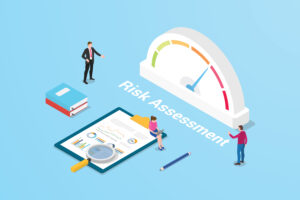Financial Risk Mitigation – A Step into the Future
We are almost halfway into 2024 and have witnessed the downfalls and uprises of so many organizations, from big conglomerates to medium and small companies. What connects to all of these fluctuations is how they use their funds, the money in the bank! You know! Decoding how they have implemented the concept of financial risk management and risk mitigation into their root systems, may it be traditional methods or the use of modern technological solutions to identify the pain points, finding opportunities to grow and make more money! Everybody loves to hear the sound of credit, Cha-ching! Correct? Risk mitigation is the way to go and grow.
Let’s see how risk mitigation is turning heads, Literally Heads! Of organizations that have seen these fluctuations, CEOs stepping down, takeovers, hedging, and what not. But before we understand mitigation i.e. reducing the likeness of any event, we should also know what is Financial risk management – briefly it means Identifying, assessing, and mitigating potential risks that could impact the financial objectives by keeping a proactive approach, safeguarding assets, and finding opportunities.
Understanding Financial Risk Mitigation
Risk Mitigation, as discussed earlier it’s a part, an essential one of FRM wherein it encompasses the fundamentals of overall management and is bound to take actions to reduce the probability of risks occurring in the first place.
 Standing at the forefront of well-advised financial management, it helps us understand how to effectively elude financial risks, it’s not just about safeguarding assets or escaping a loss, but also focuses evenly on ensuring long-term stability and growth. The risks may arise due to market volatility, credit risks, or operational uncertainties, effective risk mitigation strategies aim to minimize the probability and impact of adverse events.
Standing at the forefront of well-advised financial management, it helps us understand how to effectively elude financial risks, it’s not just about safeguarding assets or escaping a loss, but also focuses evenly on ensuring long-term stability and growth. The risks may arise due to market volatility, credit risks, or operational uncertainties, effective risk mitigation strategies aim to minimize the probability and impact of adverse events.
Importance of Risk Assessment
The core of risk mitigation lies in the process of risk assessment. By thoroughly studying the chances or probability and potential consequences of various risks, individuals and organizations can make informed decisions and implement proactive measures to mitigate vulnerabilities. This considerably increases the chances of your project/operations resulting into success.
Types of Risks in an Organization
Market Risk: The possibility of losses happening to financial assets as a result of overall financial market movements. For example, a stock significantly dropping in price.
Credit Risk: The risk that comes with a party that is in contract but fails to meet on their agreed-upon obligations. For example, an individual/organization defaulting on their loan repayments
Liquidity Risk: The possibility that the cash flow is not matched with the funds available with the organization. For example, an estate being bought as an asset but could not be sold due to it’s value proposition.
Operational Risk: The risk that arises from a flawed internal process, personnel, or system/systems. For example, an employee incorrectly processes a deal resulting in monetary loss.
Risk Mitigation Strategies to Follow
We now know how important Risk Mitigation for any entity is, what types of risks it can incur, and what probability it holds in terms of unlocking the full potential for them. So let’s discuss the how-to part of the mitigation techniques. Mitigation as we know is the actionable operation that are to be taken upon assessment of the structure. Effective strategies are essential for safeguarding the assets and ensuring stability, this will vary from Industry to industry based on the processes, services and operations. That said there are some key rules, or to be precise steps that one can follow to ensure the best results. Once the final assessment reports are ready, it will highlight the probable causes that may affect the organization. The best ways to get ahead of the situation are as follows:
- Diversifying the investments portfolio
- Hedging against the market fluctuations
- Insurance against probable causes
- Implementing unparalleled risk management frameworks
If all is done right, individuals and organizations can mitigate the impact of unforeseen events and optimize for the best Return on investments.
Diversification: Diversification remains the priority when assessing risk mitigation, it allows the investor to spread risks across different assets and sectors. It means even if one pillar of your structure is shaken or made vulnerable to a potential threat, it will not have any severe effect on the other holding pillars.
Hedging: Hedging is a method to reduce the loss caused by price fluctuations. It includes the steps of buying/selling equal quantities of the same or very similar goods at nearly the same time, in two different markets, assuming that a future price change in one market will be offset by an opposite change in the other market
Insurance: Insurance as we all know is one of the best practices to reduce the financial impact of any interruptions that may incur in a business, may it be due to loss or damage. It acts as a safety net ensuring that there is minimal loss, subject to the terms of the policy, a properly structured policy wavers the impact considerably.
The final point being Implementing risk management frameworks which speaks for itself, if one has done their due diligence in assessment and best practices within the ecosystem, it is like a firewall against the threats that one might come across. Unparalleled being a keyword that states a system that breaks the norms of just the necessary and taking a leap in the direction of all thats possible for effective risk mitigation .
Leveraging Technology for Risk Management
In an era defined by technological advancement, the use of innovative tools and platforms to improve financial risk management practices is critical. From predictive analytics to automated trading algorithms, the use of technology enables real-time risk monitoring and strategic decision-making, allowing stakeholders to stay shoulder to shoulder of market trends and potential threats.
Embedding Legal Compliance
Compliance with regulatory frameworks is essential to reduce financial risks and ensure accountability. Key regulations such as Basel III for banks and Solvency II for insurers establish minimum capital requirements and risk management standards to promote financial stability.
Building Resilience
Contingency planning and stress testing are essential parts of effective risk management, taking into account the identification of potential vulnerabilities and the development of response strategies while taking required actions for risk mitigation. By simulating harmful scenarios, companies can assess their resilience and make the necessary changes.
Building a Risk-aware culture
Developing a culture of risk awareness within companies encourages proactive risk detection and handling across the entire organization. Businesses are able to assist employees carry out risk management tasks more successfully by encouraging openness, responsibility, and information sharing.
Conclusion
Avoiding inconsistency is not the only way to reduce financial risk. It has been involved with their strategic adoption. By understanding the characteristics of monetary hazards, using technology, adhering to guidelines, and building a risk-taking mindset, people and establishments can effectively manage obstacles and benefit on opportunities for growth which underlines why financial risk mitigation is a step into the future.
Frequently Asked Questions
Q: How does financial risk mitigation differ from risk avoidance?
A: Financial risk mitigation involves proactively identifying risks, assessment and control, while risk prevention aims to eliminate risk altogether.
Q: What is technology in today’s risk management strategies?
A: Technologies such as artificial intelligence and big data analysis enable real-time risk. mitigation monitoring, predictive modeling and automated decision-making that improves risk management.
Q: How can companies ensure compliance to ensure effective compliance risk management?
A: Companies can ensure compliance by staying current with relevant regulations and applying robust risk. management frameworks and regular audits to assess compliance with regulatory requirements.
Q: What are common challenges in implementing risk management strategies?
A: Common challenges include balancing risk-taking and risk mitigation, keeping pace with regulatory changes, and navigating complex financial markets.
Q: How does building a risk awareness culture benefit organizations?
A: Creating a risk culture promotes transparency, accountability, and proactive risk identification and management, which improves an organization’s resilience and adaptability in the face of uncertainty.








